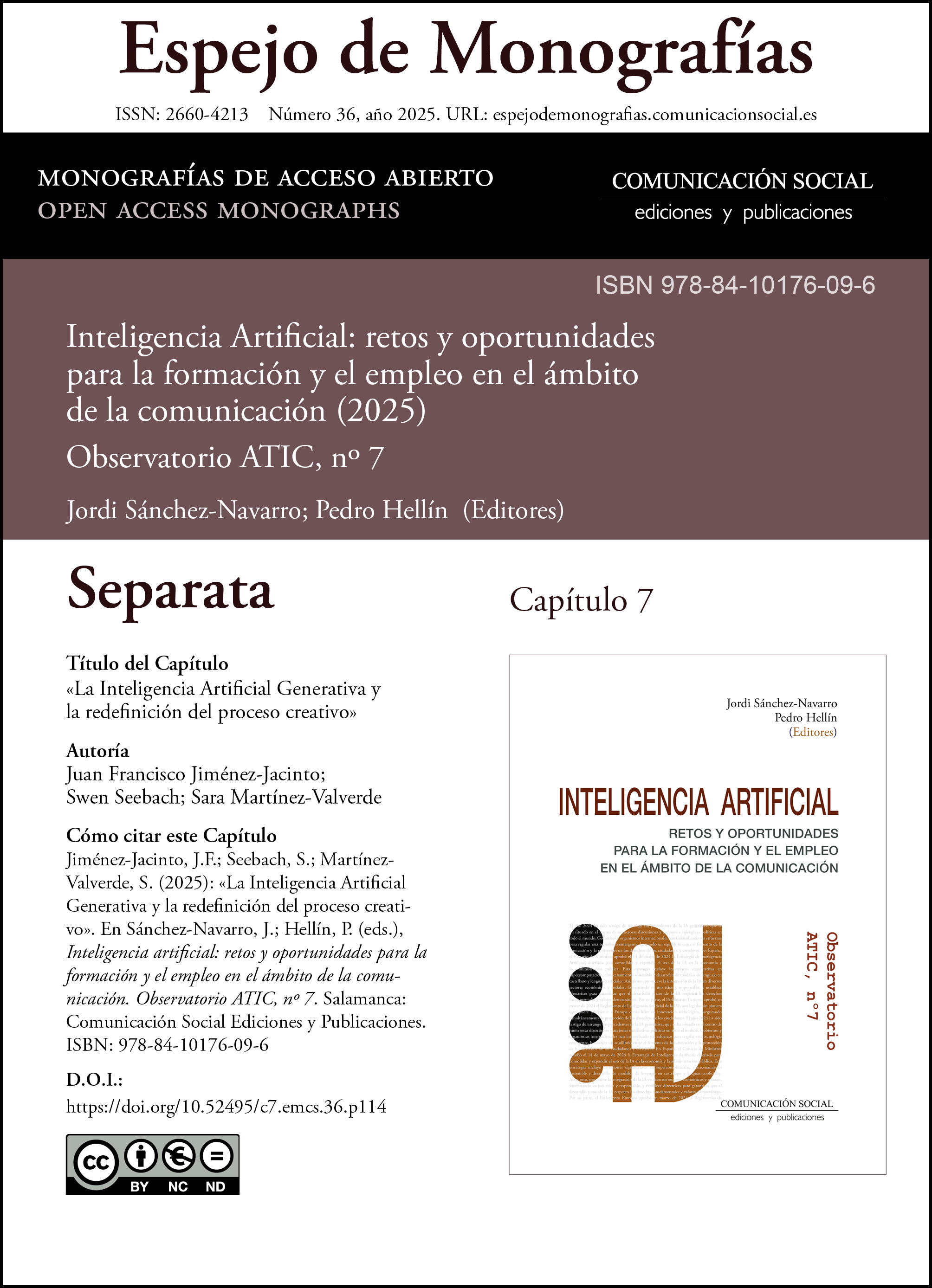Capítulo 7. La Inteligencia Artificial Generativa y la redefinición del proceso creativo
DOI:
https://doi.org/10.52495/c7.emcs.36.p114Palabras clave:
Inteligencia artificial generativa, proceso creativo, creatividad, arte, publicidad, audiovisual.Resumen
El presente capítulo reflexiona sobre el modo en que la inteligencia artificial generativa (IAG) está redefiniendo el proceso creativo en disciplinas como el arte, la publicidad y la producción audiovisual. A través de un enfoque crítico y apoyado en ejemplos concretos, se analizan tanto las oportunidades que ofrece esta tecnología para optimizar tiempos, experimentar con nuevos lenguajes visuales y democratizar el acceso a la creación, como los dilemas éticos que plantea. Cuestiones como la autoría, la autenticidad o la transparencia en el uso de la IAG se presentan como desafíos urgentes que afectan no solo a los creadores, sino también a las instituciones culturales y al público. Asimismo, se propone una reflexión sobre las implicaciones de estos cambios, especialmente en relación con las nuevas formas de producción y distribución del valor en contextos donde los datos y los algoritmos comienzan a ocupar un lugar central.
Descargas
Citas
Ardhianto, P.; Santosa, Y.; Pusparani, Y. (2023). A Generative Deep Learning for Exploring Layout Variation on Visual Poster Design. International Journal of Visual and Performing Arts. https://doi.org/10.31763/viperarts.v5i1.920.
Akten, M. [Memo Akten]. (2018). Deep Meditations [Video]. YouTube. https://www.youtube.com/watch?v=BLmYXfPZYX8&t=90s
Baek, T. H. (2023). Digital Advertising in the Age of Generative AI. Journal of Current Issues & Research in Advertising, 44(3), 249-251. https://doi.org/10.1080/10641734.2023.2243496
Blazhev, B. (2023). Artificial Intelligence and Graphic Design. Cultural and Historical Heritage: Preservation, Presentation, Digitalization. https://doi.org/10.55630/kinj.2023.090109.
Bryant, J. (2004). Critical Communication Challenges For the New Century. Journal of Communication, 54, 389-401. https://doi.org/10.1111/J.1460-2466.2004.TB02635.X.
Brynjolfsson, E.; McAfee, A. (2014). The second machine age: Work, progress, and prosperity in a time of brilliant technologies. W.W. Norton & Company.
Chacón, J.C.; Nimi, H.M.; Kloss, B.; Kenta, O. (2020). Towards the Development of AI Based Generative Design Tools and Applications. Proceedings of the 22nd International Conference on Engineering Design (ICED), 63-73.
Chatterjee, A. (2022). Art in an age of artificial intelligence. Frontiers in Psychology, 13. https://doi.org/10.3389/fpsyg.2022.1024449.
Cheng, M. (2022). The Creativity of Artificial Intelligence in Art. The 2021 Summit of the International Society for the Study of Information. https://doi.org/10.3390/proceedings2022081110.
Epstein, Z.; Hertzmann, A.; Herman, L.; Mahari, R.; Frank, M.; Groh, M.; Schroeder, H.; Smith, A.; Akten, M.,;Fjeld, J.; Farid, H.; Leach, N.; Pentland, A.; Russakovsky, O. (2023). Art and the science of generative AI. Science, 380, 1110 -1111. https://doi.org/10.1126/science.adh4451.
Gardner, H. (1983). Frames of mind: The theory of multiple intelligences. Basic Books.
Gervais, D. (2019). The Machine as Author. Iowa Law Review, 105(5), 2053-2106.
Goodfellow, I.J.; Pouget-Abadie, J.; Mirza, M.; Xu, B.; Warde-Farley, D.; Ozair, S.; Bengio, Y. (2014). Generative adversarial nets. In Advances in neural information processing systems (pp. 2672-2680).
Kar, S.; Roy, C.; Das, M.; Mullick, S.; Saha, R. (2023). AI Horizons: Unveiling the Future of Generative Intelligence. International Journal of Advanced Research in Science, Communication and Technology.
Mandapuram, M.; Thodupunori, S.; Bodepudi, A.; Reddy, M. (2018). Investigating the Prospects of Generative Artificial Intelligence. Asian Journal of Humanity, Art and Literature. https://doi.org/10.18034/ajhal.v5i2.659.
Marx, K. (1867). El Capital: Crítica de la economía política (Vol. 1). Hamburg: Verlag von Otto Meissner.
Mazzone, M.; Elgammal, A. (2019). Art, Creativity, and the Potential of Artificial Intelligence. Arts. https://doi.org/10.3390/ARTS8010026.
Mohseni, S.; Ragan, E. (2018). Combating Fake News with Interpretable News Feed Algorithm. ArXiv, abs/1811.12349.
Noy, S.; Zhang, W. (2023). Experimental evidence on the productivity effects of generative artificial intelligence. Science, 381, 187-192. https://doi.org/10.1126/science.adh2586.
Ran, Y. (2023). GAN and art: Facilitation of artistic production and expression based on artificial intelligence. Applied and Computational Engineering. https://doi.org/10.54254/2755-2721/16/20230887.
Searle, J.R. (1980). Minds, brains, and programs. Behavioral and Brain Sciences, 3(3), 417-457.
Silberg, J.; Manyika, J. (2019). Notes from the AI frontier: Tackling bias in AI (and in humans). McKinsey Global Institute. Recuperado de https://www.mckinsey.com/mgi/overview/our-research/notes-from-the-ai-frontier-tackling-bias-in-ai-and-in-humans.
Singh, P.; Kumar, A. (2024). Beyond Automation: Exploring the Role of AI in Enhancing Digital Marketing Effectiveness and Management Innovation.
Tiwari, R. (2023). Ethical And Societal Implications of AI and Machine Learning. Interantional Journal of Scientific Research in Engineering and Management. https://doi.org/10.55041/ijsrem17519.
Turing, A.M. (1950). Computing machinery and intelligence. Mind, 59(236), 433-460.
Verganti, R.; Vendraminelli, L.; Iansiti, M. (2020). Innovation and design in the age of artificial intelligence. Journal of Product Innovation Management, 37(3), 212-227. https://doi.org/10.1111/jpim.12517

Publicado
Cómo citar
Número
Sección
Licencia

Esta obra está bajo una licencia internacional Creative Commons Atribución-NoComercial 4.0.
Los artículos publicados en la revista se distribuyen con la Licencia Creative Commons Atribución-NoComercial-SinDerivadas 4.0 Internacional










